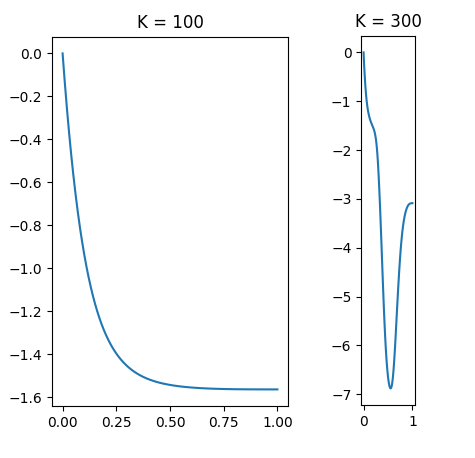I have a 2nd ODE (derived from an elastic rod deflated naturally under its self-weight):
$$
y'' + K (x – 1) \cos(y) = 0
$$
K is a constant coefficient. The variables range between $x \in [0, 1], y \in [-\pi / 2, 0]$
The BCs:
$$
y(0) = 0 \\
y'(1) = 0
$$
and a constraint $y' \le 0$ and $y'' \ge 0$ (from physical meaning).
How can I solve it numerically?
I have a weak background in the theory/classfication of ODEs, but I still tried to analysis and solve it as followed:
1. My own analysis on this problem
This is an second order nonlinear ODE. Its BCs are located in two sides, so it is a BVP.
A common practice is to split it into a 1st ODE system:
$$
\begin{cases}
y_2 = y_1' \\
y_2' + K (x – 1) \cos (y_1) = 0
\end{cases}
$$
Then I discrete all derivates by explicit euler method, and employe shooting method(where I guess the init BCs y'(0) and adjust this guess for a satisfying solution).
When K is big, I can solve it properly. But when K is small, my shooting method always failed. I have no idea how to analysis it anymore.
2. My questions
- Is my judgement about this problem correct? Is it an 2nd order ODE, Bounday value problems with not enough BCs?
- Why I can solve it properly in non-stiff case, and fail in stiff case?
- Some literatures point out that,
auto07ppackage can help me on this problem. But I cannot understand its manual even a bit. Which book should I read to handle this problem? - How can I know whether this problem have a solution?
- How to solve this problem numerically?
Sorry for my weak background in ODE.
Thanks a lot for your time!
3. solve_bvp and shooting failed when K > 200 and ignore the constraint
When K > 200, we need to set up a special init guess for solve_bvp, otherwise we will fail. Please check @Lutz 's answer below.
$


Best Answer
In python you do
The solver uses a multi-shot approach where the segments are encoded using a collocation method. This produces a huge non-linear system that is solve via Newton using sparse linear algebra.
For large $K$ you get a nearly singular DE, so that a boundary layer approach becomes advisable for the initial guess. The outer solution is $y=-\frac{\pi}2$ (or any other root of the cosine). The inner solution at the left boundary with $Y(s)=y(K^{-1/2}s)$ follows the approximate DE $$ Y''(s)=K^{-1}y''(K^{-1/2}s)\approx\cos(Y(s)) $$ This has a stable solution that approximately looks like $\frac\pi2(e^{-s}-1)$. So put that as initial guess
and I still get a solution for $K=500$,
$K=5000$ works too. It is also sufficient to simplify the initial guess to